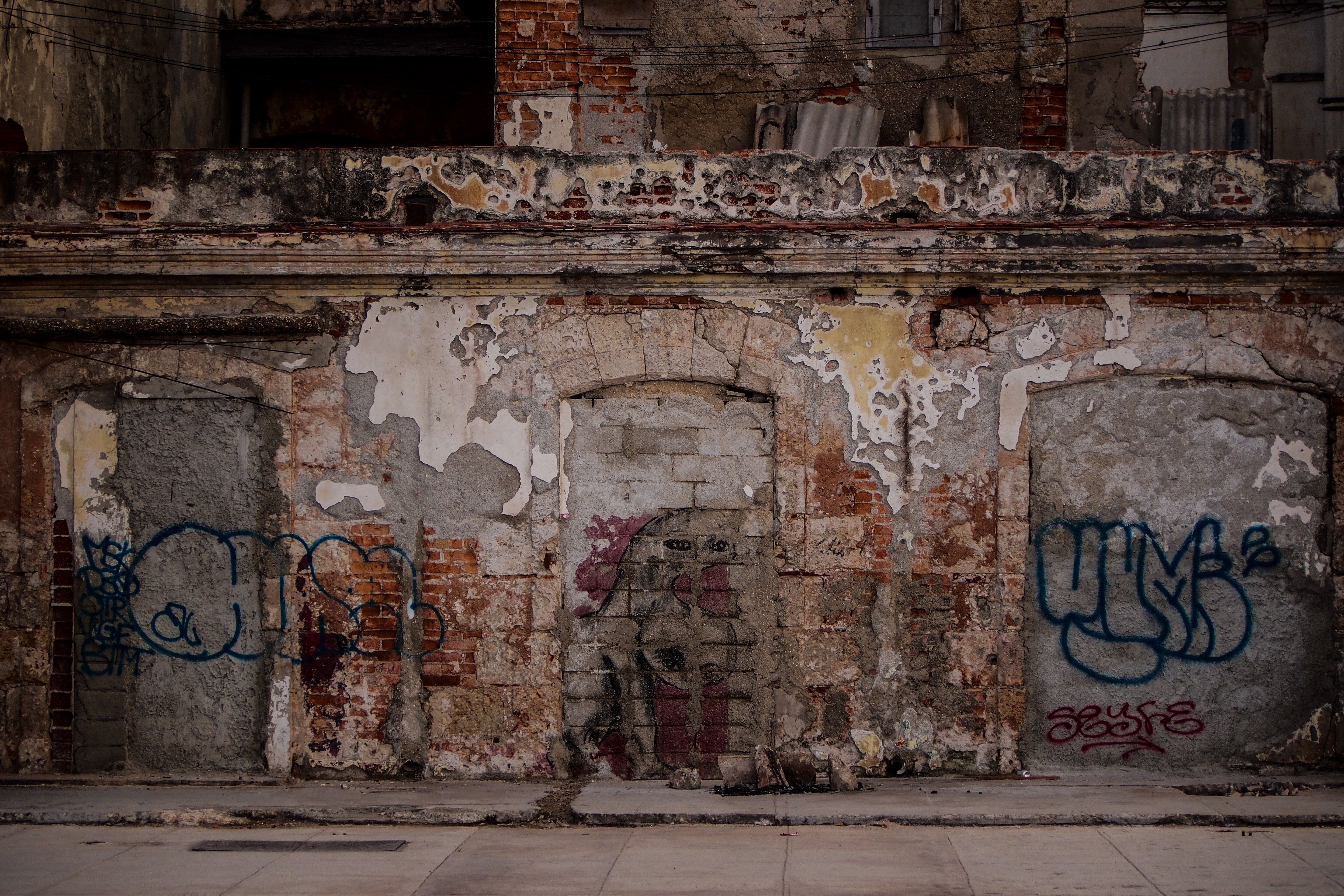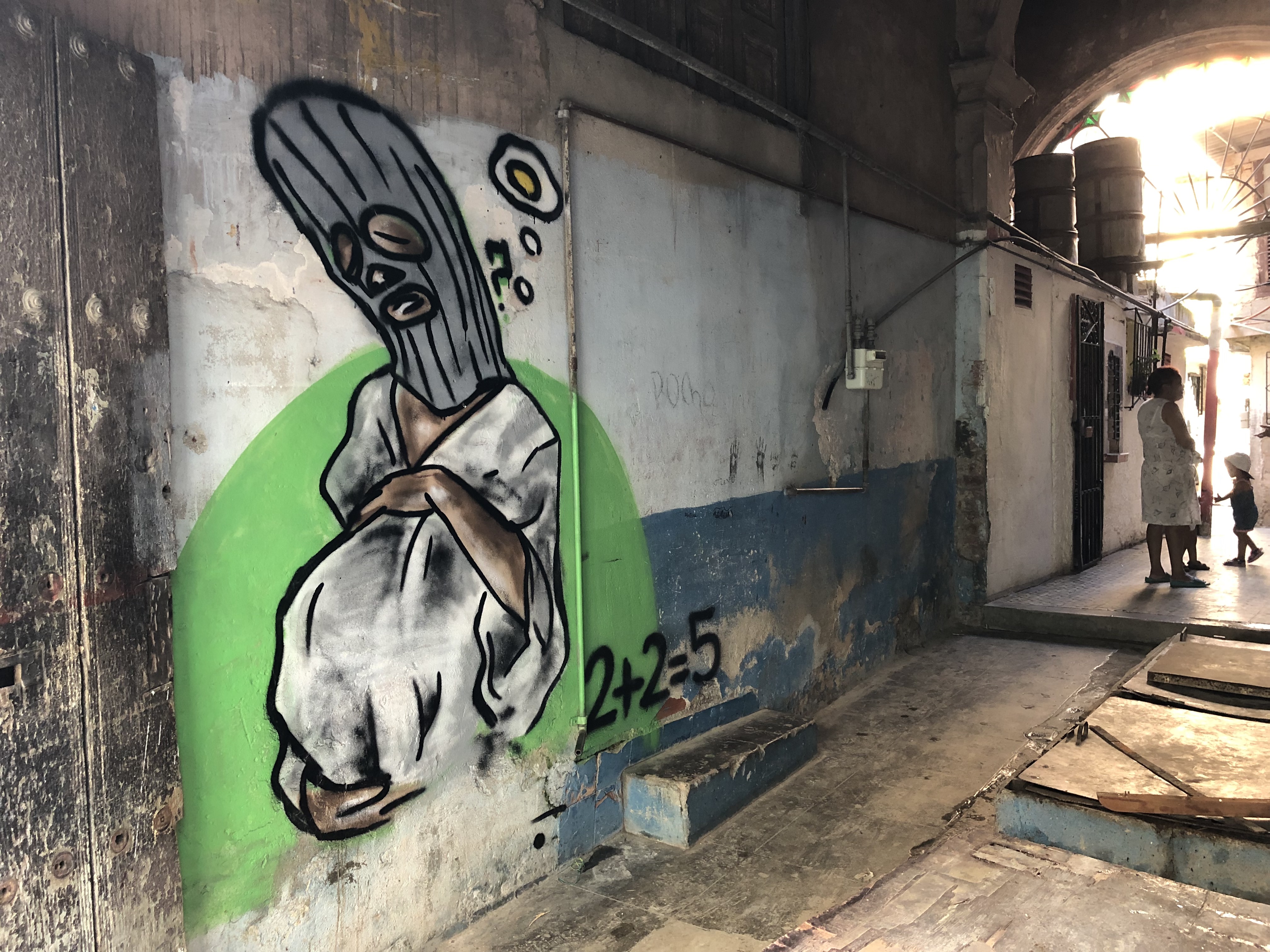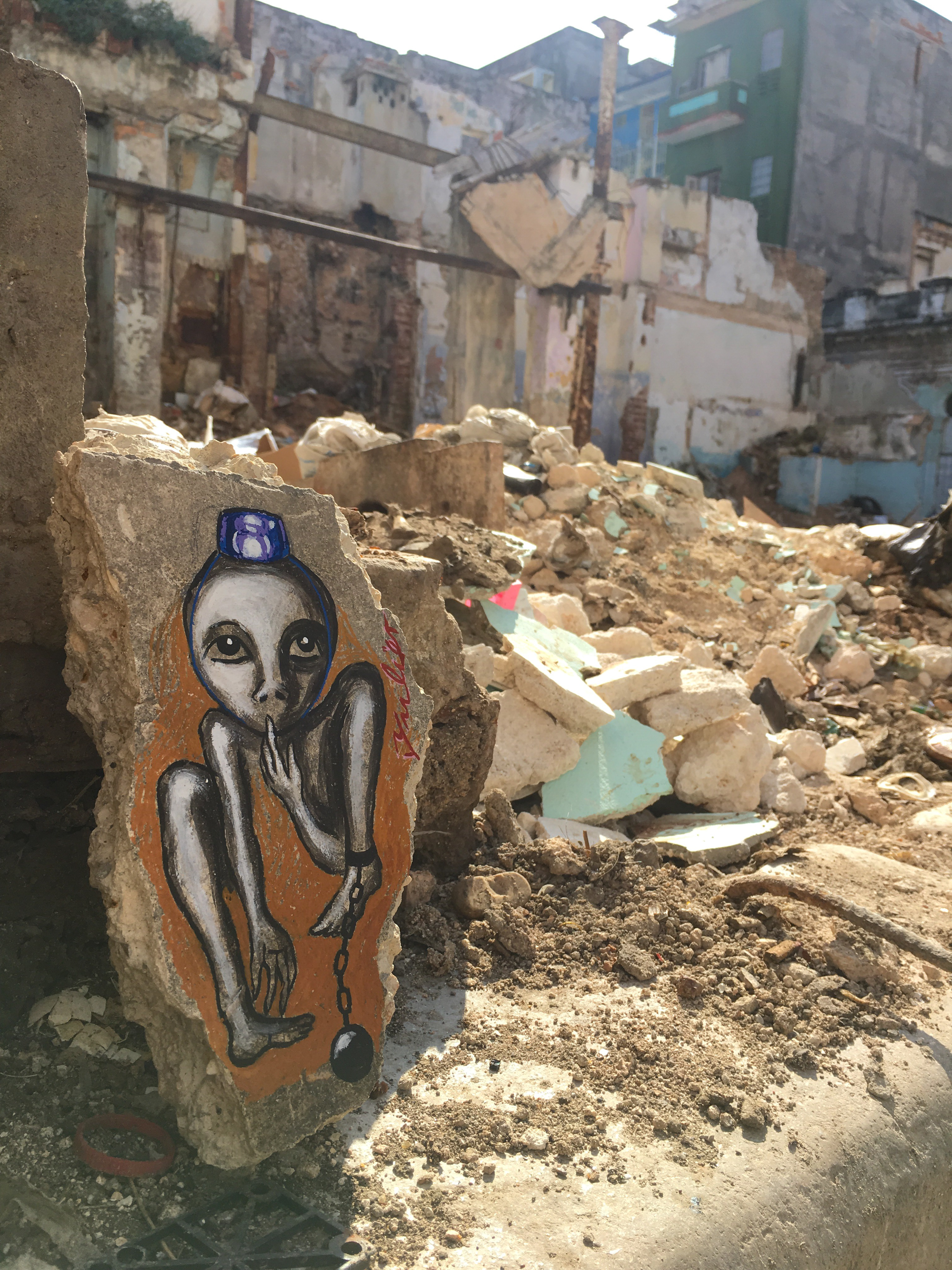
(Photo: Deni Ellis Béchard)
Yulier P. is out looking for trash. Over the past three years, his street art has been featured on scores of news sites. He has received an invitation to come to New York to prepare an exhibition, and the latest Transformers film included a close-up of one of his murals—a gray, mouthless face with wide, searching eyes—before the camera panned to a weathered street typical of Havana, the sprawling capital that is home to more than two million people, one-fifth of Cuba’s population. He has even been featured by Amnesty International, which put out an “Urgent Action” bulletin in August of 2017, identifying him an “Urban Artist at Risk.”
Now he walks the streets, scanning the garbage heaped on street corners and overflowing from dumpsters. He picks out small slabs of plaster, concrete, or masonry that are shed daily from the city’s crumbling façades. Throughout the capital, even as the government builds massive new luxury hotels to fund itself, the homes of ordinary Cubans are falling apart. A building has even recently collapsed along the famed Malecón, the seaside walk where tourists and locals congregate.
The chunks of concrete that Yulier gathers become his canvases. He carries them to his small apartment in El Centro, an impoverished neighborhood abutting the scenic and tourist-swarmed Habana Vieja. On one slab, he paints a gray figure with a strip of red cloth tied around its head, warrior-style. The figure holds a paintbrush like a rifle, the golden shaft of the handle cradled in its arms. The face is downcast, at once sad and determined. Above it is the word Contra. On another slab, Yulier paints a perplexed figure with a ball and chain on its ankle and a blue police light on its head. When the paint has dried on each one, he carries it to the street and sets it back in the trash heap where he found it. Or he leaves it on a street corner. Then he waits until he sees a passing Cuban stop, pick up the stone tableau, and carry it away.
Yulier calls this project Regalo—Gift. When I wrote about Yulier P. two years ago for Pacific Standard, he was painting murals throughout the streets of Havana, on decaying and abandoned buildings, trying to create more beauty within a city that sometimes seemed to have too little. His images then—alien and dreamlike creatures, often with misshapen bodies and screaming faces—were more evocative and less direct in their messages than his more recent creations. He said that he had created the murals from a sense of “civic responsibility … [to] use destroyed spaces and convert them, because the government doesn’t have the capacity or the funds to make repairs.”
But a few months later, he was arrested while painting a mural. The police imprisoned him for two days and taunted him, he says. They threatened him with legal action reserved for counter-revolutionaries, and laughed when he showed signs of fear.
“They kept me in a room with serious criminals, men who had committed violent acts…. The police told me my art was ugly, that it was trash. They said I was being held because of my disrespect—desacato…. They said, ‘We will let you go, but you have to sign a letter’—a declaration that said I would no longer paint on walls. I signed it because I wasn’t in stable condition psychologically. I had no support or legal guidance.”
During Yulier’s time in jail, his wife emailed me to say that he had been arrested. Later, she wrote to tell me that the police had let him go, but that they’d warned him he had one week to erase all the murals he had painted across Havana or else he would be imprisoned again. Yulier did nothing—not erasing, not painting, just stayed home while the week passed. Though the police did not return to arrest him, his street murals began vanishing; even the one featured in Transformers: The Last Knight was painted over.
Not long afterwards, the owner of the studio where Yulier made and sold paintings to support him and his wife suddenly told him that she couldn’t continue renting to him. Before that, he had been expelled from a government-owned gallery but had hoped that running an independent studio would allow him to continue his work. The police visited neighborhood bars, asking locals if Yulier was a counter-revolutionary. They began dropping in on his wife, both at her work and at the university where she studied, and even spoke to her at the couple’s home, entering unannounced and without permission, both spouses say. Over time, these external stresses, and Yulier’s own growing anxiety, drove the couple apart. She returned to live with her family, though the couple still speaks often.
Having lost his studio and no longer allowed to paint murals, Yulier says that at first he was unsure what to do with his time. His solution was Regalo, so named because he was creating art that could enliven, for free, the homes of his fellow Cubans, the vast majority of whom are impoverished and live on government salaries of less than a dollar a day (though remittances from relatives living abroad and black market earnings increase this amount for many). Yulier hoped to add beauty to their lives by leaving art in the street for them to find—art that might express, and sublimate, the rage and frustration many Cubans felt toward an oppressive government.
During this time, Yulier also began painting the tops of the bicycle taxis that cart people around the city. Seen from the street, the plastic or canvas tops that shade passengers from the sun are invisible, but from the city’s many balconies and rooftops where people congregate, the bicitaxis—also the name he gave to this project—became ambulant murals.
Yulier sees Regalo and Bicitaxi as a means of resistance—and of educating people about free speech and public art. He has produced videos for both projects, as well as other short films, in which he speaks with Cuban artists about their struggles with oppression. Since the Internet in Cuba is strictly limited to government-controlled hotspots that have poor bandwidth and are expensive—paid for by the hour—few Cubans have access to it for anything more than basic messaging, if that, given the inflated cost of smartphones there.
Since streaming and sharing video in Cuba is so difficult, Yulier plans to distribute his films via El Paquete, the underground Cuban “Internet,” which consists of terabyte hard drives loaded with media—usually television series, soap operas, video clips, movies, music, and black-market classifieds, as well as websites whose content ranges from the news to educational material to advertisements. El Paquete is carried from house to house each week and works on a subscription basis, with people paying a fee scaled in relation to how much of it they get to copy to their own drives and devices.
In a city with a booming black market—in which almost everyone is buying and selling, exchanging money, cracking software, unlocking phones—El Paquete was one of the most important recent innovations, and Yulier has been developing plans to create something like a channel on it, through which he might continue to share his political art openly.
The Case of Fabián
Around the same time that Yulier was transitioning to painting on garbage, Fabián, another street artist whose career I also wrote about two years ago, saw similar problems. While Fabián hasn’t been banned from painting murals, most of those he has created have been erased, and, like Yulier, he has been forced out of the studio where he used to work. Both he and Yulier are largely supported by foreign artists, studios, and customers, and both of them have made trips out of the country—Fabián most recently to France. He also receives income from Canada, where his images are printed on T-shirts. In Havana, he continues to paint Supermalo, his signature character who wears a balaclava. At first glance you might think it’s the figure of a gangster, but Supermalo’s balaclava in fact represents the hidden faces of silenced Cubans. One mural shows a pregnant woman in a balaclava holding her belly while another depicts a balaclava-wearing Jesus making a peaceful hand gesture.
Both Fabían and Yulier speak critically of the new Cuban government, whose president, since April of 2018, has been Miguel Díaz-Canel. For the first time since 1976, a Castro does not hold the presidency, and yet the presidency is only the second most powerful position after the first secretary of the Communist Party of Cuba, a post still occupied by Raúl Castro.

(Photo: Deni Ellis Béchard)
One of Díaz-Canel’s first acts as president was to sign into law Decree 349, which strictly regulates the production of art, prohibiting all artists—musicians and performers included—from creating unapproved art in public or private spaces. Amnesty International has spoken out against the law, quoting some of its more dystopian clauses, such as those banning audiovisual content that has “patriotic symbols that contravene current legislation” (Article 3a) and “sexist, vulgar or obscene language” (Article 3d), or that “violates the legal provisions that regulate the normal development of our society in cultural matters” (Article 3g).
In discussing the new law and government, Fabián is muted and circumspect in his statements. “They don’t interest me,” he says, quietly and unconvincingly. “They don’t affect me.”
Yulier, on the other hand, speaks out strongly. He says that the new president wasn’t chosen by the people and that Cuban citizens don’t embrace him. “I didn’t elect him…. There was no discussion,” Yulier says. “Legitimacy isn’t [based purely in] military power.”
Yulier echoes the words of Amnesty International in saying that the wording of Decree 349 is too vague and sweeping, with its statements forbidding Cubans to “commercialize books with content harmful to ethical and cultural values” (Article 4f).
Many other Cubans I met spoke out against the law. They described theater companies being closed across the city, artistic institutions losing funding, and the absurdity of “art inspectors” who go around the country determining if the art they see is legal.

During my last visit to Havana, I heard Cubans I have known for years, and who have never spoken out against the government to me, do so bitterly. While some of them aimed their anger at Donald Trump, citing his influence as the cause for decreased tourism and harder times for Cuban families, most vented against their own country’s leadership.

(Photo: Yulier P.)
Some talked about the absurdity of laws dictating that Cubans living in the countryside or in small towns need government permission to move to Havana. The unauthorized thousands who did so couldn’t receive the food subsidies guaranteed to all Cubans under socialism but instead had to live as refugees. “Even then,” someone pointed out to me, “they have more opportunity here than they did elsewhere in the country. That’s how bad things are in much of Cuba.”
One Cuban, speaking of the lack of change under the new president, told me, “They gave him the TV, but not the mandate.” Another raged at the government for removing the right to gay marriage from the new constitution: “What does our supposed fight against imperialism stand for if we oppress our own people?”
Yet the same Cubans expressed resentment over the United States’ embargo against Cuba that, in their account, had isolated their government and created a monster of it—one that continued to siphon off Cuba’s wealth in the name of “national defense.” Another Havana resident spoke to me, echoing statements I had heard from many others: “We want change, but we don’t want civil war. We don’t want violence. We want our voices to be heard, but there is no way in our current political system for us to put forth candidates who represent us.”
In light of this rage, the government’s fear of artists makes sense. Both Fabián and Yulier are creating images that communicate, often indirectly, a frustration felt deep and wide throughout Cuba. The simple act of painting on crumbling walls with such care and detail indicates the dissatisfaction among—and lack of opportunity for—a generation whose passion and talent cannot find a socially accepted venue for self-expression.
Yulier calls Regalo a “weapon of defense,” saying, “Denunciation is the beginning of the path to liberty and justice.”
And yet Yulier, like Fabián, never voices a desire to leave the country permanently. As I walk with Yulier in the street, people often call out to him from balconies and doorsteps, or stop to greet him and shake his hand.
“Would you live anywhere else?” I ask him.
“No,” he says. “This is my home. I like it here.”

Pacific Standard’s Ideas section is your destination for idea-driven features, voracious culture coverage, sharp opinion, and enlightening conversation. Help us shape our ongoing coverage by responding to a short reader survey.





